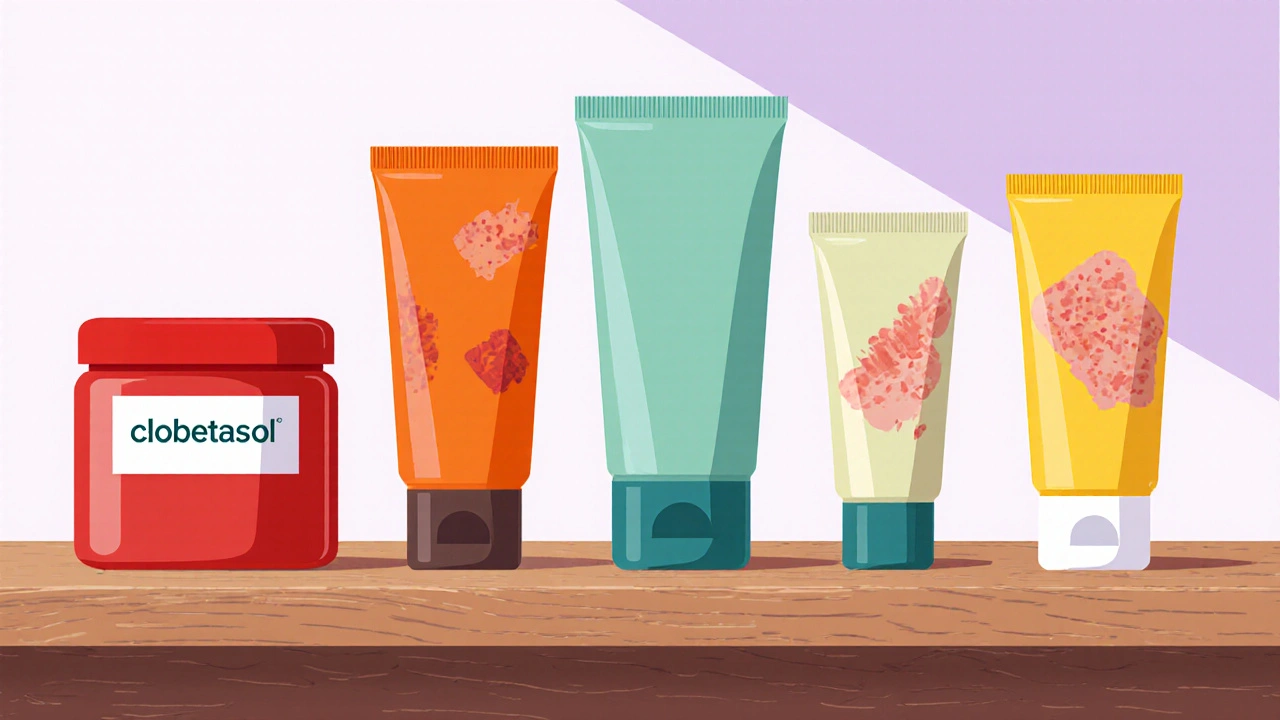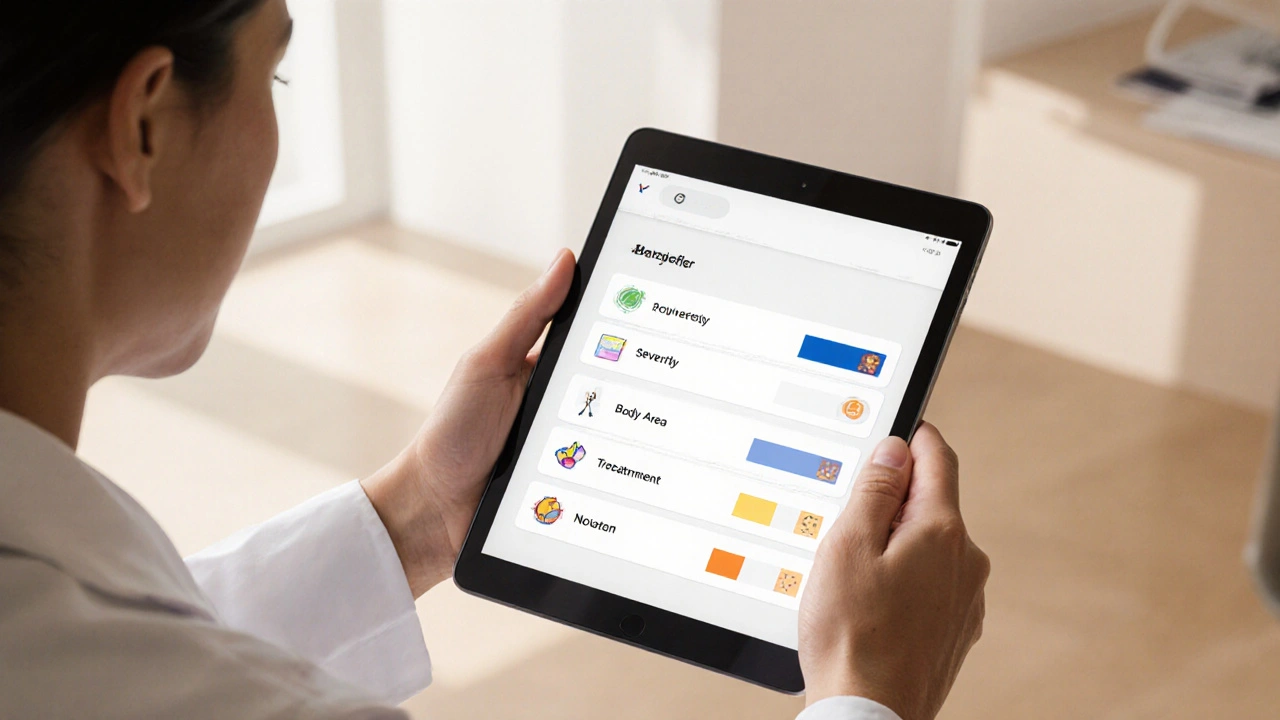Topical Steroid Selector
Select your condition details to get a personalized recommendation.
Why This Recommendation?
TL;DR
- Tenovate (Clobetasol Propionate) is the most potent prescription steroid cream in the US.
- It’s best for short‑term use on tough skin conditions like psoriasis or severe eczema.
- Safer, lower‑potency options include Betamethasone Dipropionate, Mometasone Furoate, and Desonide.
- Watch for side effects like skin thinning, stretch marks, and systemic absorption.
- Pick an alternative based on potency, condition severity, area of application, and cost.
What is Tenovate (Clobetasol Propionate)?
When you hear the name Tenovate is a prescription‑strength topical corticosteroid whose active ingredient is Clobetasol Propionate. It belongs to the class of super‑potent steroids (ClassI in the U.S.) and is marketed as a cream, ointment, or scalp lotion. Doctors often reserve it for flare‑ups that haven’t responded to milder creams.
How Tenovate Works
Clobetasol Propionate binds to glucocorticoid receptors in skin cells, shutting down the inflammatory cascade that causes redness, itching, and swelling. The result is rapid symptom relief, usually within a day or two. Because it’s so strong, the drug also slows down skin cell turnover, which helps flatten thick plaques in psoriasis.
Key Factors to Compare Steroid Creams
Before you pick a cream, think about these five criteria:
- Potency level - Ranges from low (hydrocortisone) to super‑potent (clobetasol).
- Prescription status - Some need a doctor’s note, others are over‑the‑counter.
- Typical use cases - Psoriasis, eczema, lichen planus, scalp disorders, etc.
- Side‑effect profile - Skin thinning, striae, telangiectasia, HPA‑axis suppression.
- Cost & insurance coverage - Brand‑name clobetasol can be pricey; generics or lower‑potency alternatives are cheaper.
Side‑by‑Side Comparison Table
| Brand / Generic | Potency (US class) | Prescription? | Best for | Common side effects | Typical cost (30g) |
|---|---|---|---|---|---|
| Tenovate | ClassI (super‑potent) | Yes | Severe psoriasis, refractory eczema, scalp plaques | Skin thinning, stretch marks, possible systemic absorption | ≈ $120-$150 (brand) / $60-$80 (generic) |
| Betamethasone Dipropionate | ClassII (high‑potency) | Yes | Moderate‑to‑severe eczema, psoriasis | Mild skin atrophy, bruising | ≈ $40-$70 |
| Mometasone Furoate | ClassIII (mid‑potency) | Yes (some OTC in low strength) | Atopic dermatitis, facial rashes | Less skin thinning, occasional burning | ≈ $25-$45 |
| Desonide | ClassIV (low‑potency) | OTC in many states | Diaper rash, mild eczema, periorbital areas | Rare irritation, minimal thinning | ≈ $10-$20 |
| Hydrocortisone | ClassV-VI (very low‑potency) | OTC | Minor itching, insect bites, sunburn | Very low risk of atrophy | ≈ $5-$12 |

When to Choose Tenovate
If you’ve tried a mid‑potency cream for two weeks and the rash is still thick and painful, Tenovate might be the next step. Doctors typically prescribe it for a short course-often 2‑4 weeks-because the risk of skin thinning rises sharply after that. It works best on small, well‑defined areas like scalp plaques or palmoplantar psoriasis.
Because it’s a super‑potent steroid, you shouldn’t use it on the face, groin, or underarms unless a specialist says it’s absolutely necessary. Those thin‑skinned zones absorb the drug faster, which can trigger systemic side effects.
Best Alternatives for Different Situations
Not every skin problem needs a super‑potent steroid. Below are the most common scenarios and the alternative that balances efficacy with safety.
1. Mild to moderate eczema on the arms or legs
Mometasone Furoate is a solid mid‑potency option. It calms itching quickly and carries a lower chance of thinning. Many pharmacies stock a 0.1% cream over the counter, so you can start without a prescription.
2. Diaper rash or periorbital dermatitis
For ultra‑delicate areas, Desonide provides just enough anti‑inflammatory power without the harsh side effects of stronger steroids. It’s often recommended for babies and for skin around the eyes.
3. Chronic plaque psoriasis covering large body surfaces
When the disease is widespread, rotating between Betamethasone Dipropionate (high‑potency) and a non‑steroidal treatment like a calcineurin inhibitor can keep flare‑ups in check while sparing you from months of clobetasol exposure.
4. Quick relief for a one‑off allergic reaction
A 1% Hydrocortisone cream is often enough. It’s cheap, easy to find, and the risk of skin atrophy is negligible.
5. Scalp psoriasis that won’t respond to OTC shampoos
If a standard shampoo isn’t cutting it, a short course of Tenovate scalp lotion may be prescribed. However, some patients respond well to Betamethasone Dipropionate scalp solutions, which have slightly less potency but still pack a punch.
Safety Tips & Common Pitfalls
- Don’t over‑apply. Use a thin layer-about the size of a pea-for each affected area.
- Follow the doctor’s timeline. Stop using the cream when symptoms improve, unless directed otherwise.
- Avoid occlusion unless advised. Covering the area with a bandage can boost absorption and raise side‑effect risk.
- Watch for systemic signs. Unexplained weight gain, high blood pressure, or mood changes could hint at HPA‑axis suppression.
- Check interactions. Using other potent steroids on nearby skin can compound effects.
Quick Checklist Before You Apply
- Is the condition severe enough for a high‑potency steroid?
- Do you have a prescription or a recommended OTC alternative?
- Is the treatment area thin‑skinned (face, folds, genitals)?
- Do you have a plan to taper off after symptoms improve?
- Have you reviewed possible side effects with your pharmacist?
Frequently Asked Questions
Can I use Tenovate on my face?
Usually no. The skin on the face is thin and absorbs the drug quickly, which can cause noticeable thinning and visible blood vessels. If a dermatologist thinks it’s essential, they’ll give a very short‑term, low‑frequency schedule.
How long is it safe to stay on Tenovate?
Most guidelines suggest 2‑4 weeks of continuous use, followed by a break or step‑down to a lower‑potency steroid. Longer use increases the risk of skin atrophy and systemic effects.
Is there an over‑the‑counter version of clobetasol?
No. Clobetasol Propionate is classified as a prescription‑only medication in the United States because of its high potency.
What should I do if I notice skin thinning?
Stop the steroid immediately and contact your healthcare provider. They may suggest a tapering schedule, switch to a lower‑potency cream, or add a barrier ointment to help the skin recover.
Can Tenovate cause hormonal issues?
Rarely, but prolonged use over large areas can suppress the hypothalamic‑pituitary‑adrenal (HPA) axis, leading to lower cortisol levels. Symptoms might include fatigue, dizziness, or low blood pressure. If you experience these, seek medical advice.

Comments (13)